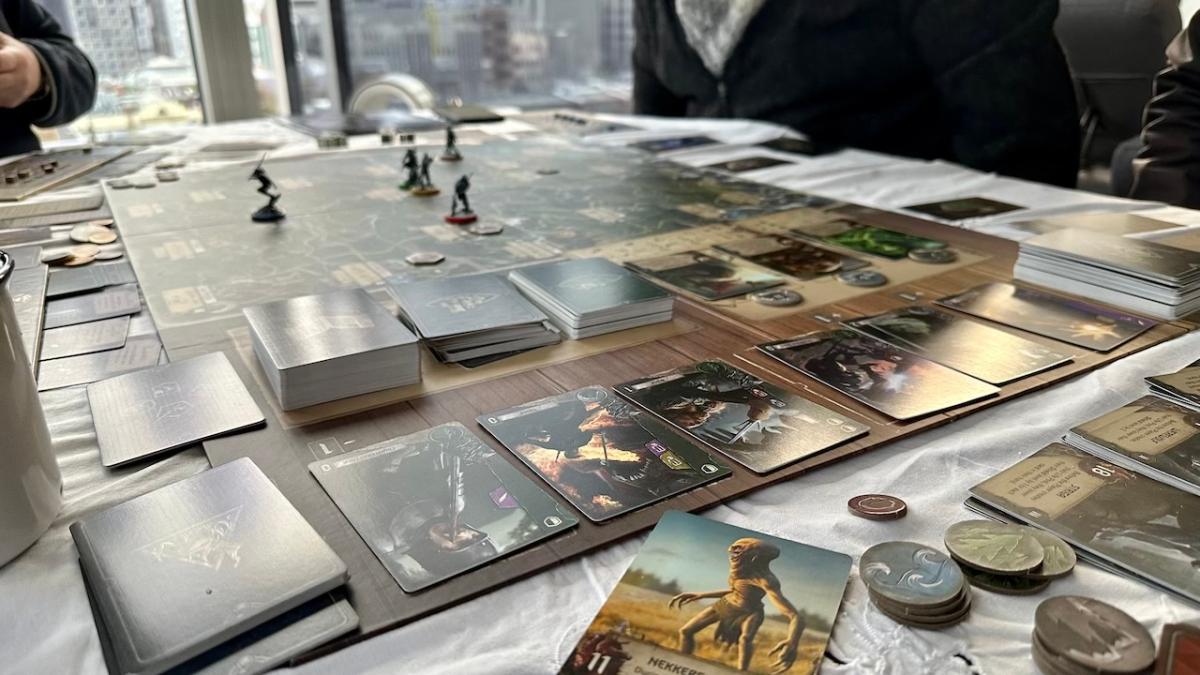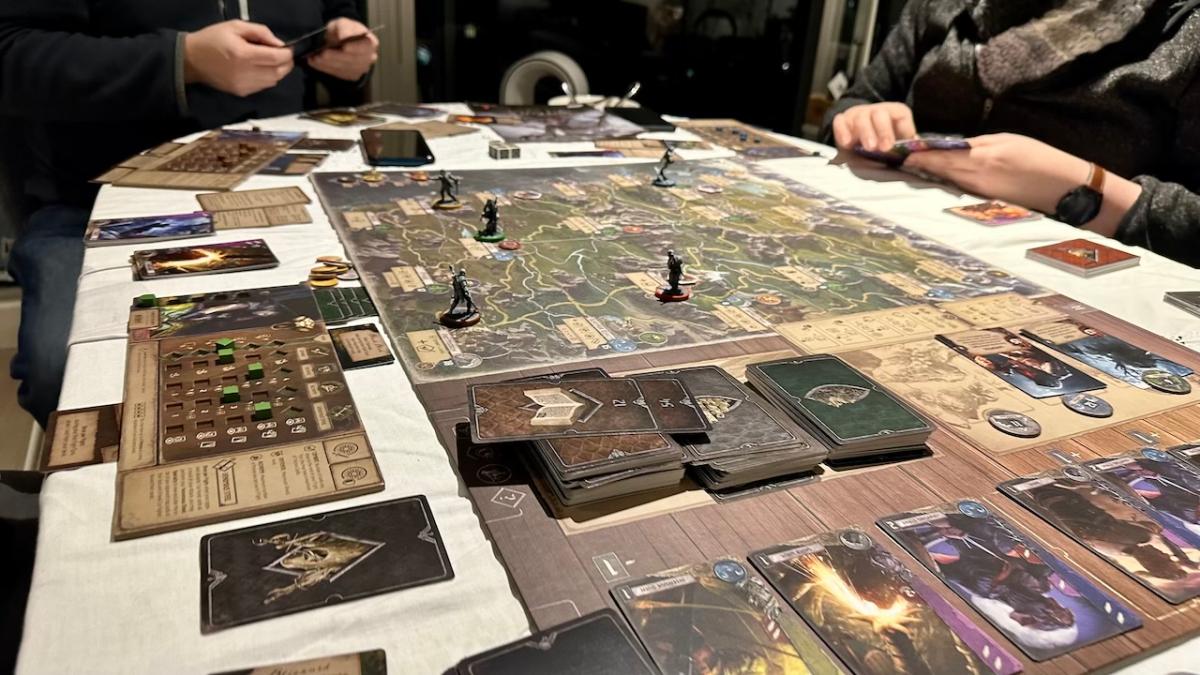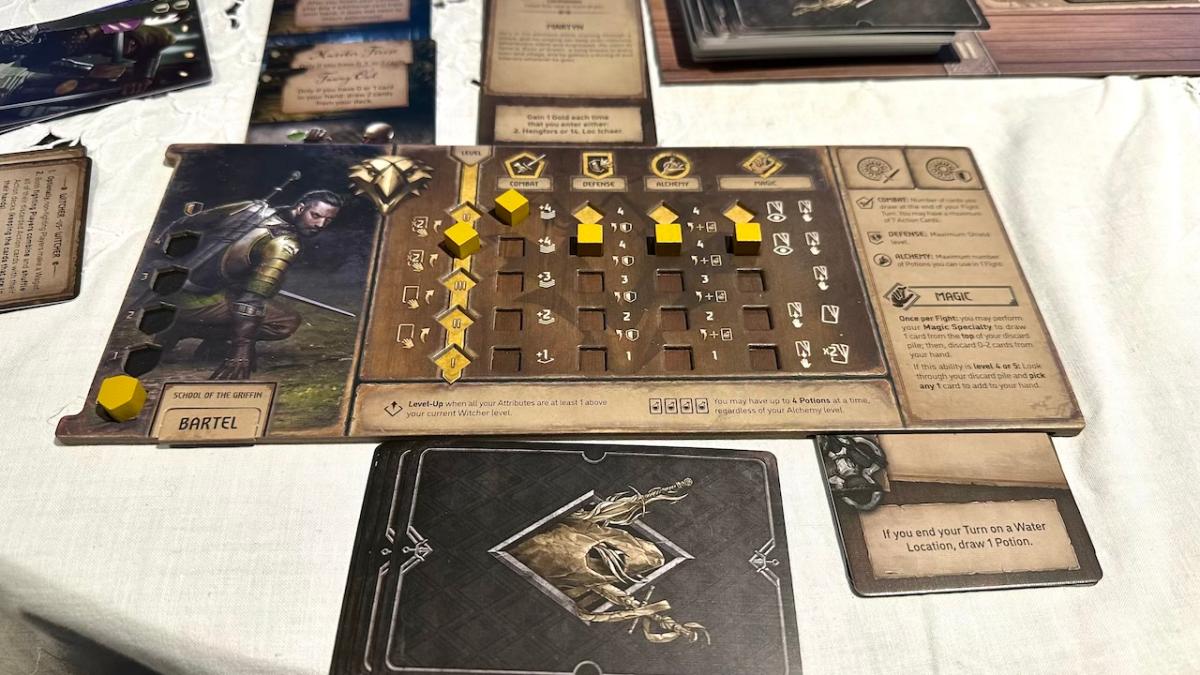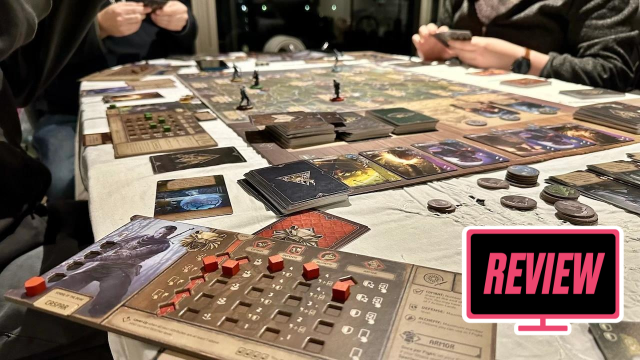We all have to acknowledge something: almost all board game adaptations of video games are bad. Some of them, you can see what they’re going for and have a good enough time that you feel like you got your money’s worth. But I can’t remember the last time I played a board game based on a video game and came away thinking about how much I loved the experience without having to reach for my love of the original video game as a crutch. Games based on books can also be pretty hit-and-miss (though, a bit more hit-than-miss than their videogame adaptation cousins). So, going into The Witcher: Old World board game, I have to admit that I had some trepidation. I knew it was going to be long, overly detailed, likely retain some of the misogyny of the original series, and that the rule book was translated from another language (Polish, originally), which can be a bit hit and miss.
However, I’m pleased to report that, despite my concerns, I had a wonderful time with The Witcher: Old World, and I look forward to playing it several more times in the future and possibly picking up any expansions. It’s a long way off being a perfect experience, but with the right group, it’s a really fun board game that stays true to the spirit of the books, rather than the video game, without getting too bogged down in trying to be a tabletop version of a whole book or video game series. It’s its own thing, focussing on capturing the vibes above all else, and something Witcher fans and newbies alike can enjoy, as long as they’re down for 2-5 hours of detailed play.
Setting Up The Witcher: Old World

For a game that’s actually pretty simple when it comes down to it, it sure does have a lot of bits. There are so many different decks of cards, fiddly coins (that all look different but are actually the same), tokens, monsters, dice, and other accoutrements.
For a five-player game, and the first time any of us had played it multiplayer, the set-up took a bit over an hour.
There were a few elements that definitely could have been streamlined. For example, there did not need to be that many different decks of cards because there is a lot of illusion of choice when choosing between the areas to explore. And, while having the little pop-outs for the different Witcher names was a nice touch, it just added to the sheer volume of stuff that can seem a bit overwhelming at first.
Of course, the more you play, the easier set-up gets, and there is nothing inherently wrong with a game that requires a lot of set-up. It is, however, just a good thing to be aware of.
Having just asked for fewer cards, I do think it would have been nice if, in addition to the cards explaining what happens during a turn and how fights work, there had been another card for each player explaining what all the symbols meant. Yes, they are in the rule book, but it would have been handy to have that quick reference available. Perhaps next time I might just photocopy the book so everyone can have a copy, but it still would have been nice to have included in the box. Because, and I cannot stress this enough, there are a lot of symbols everywhere. Some of them look really similar, too.
Actual Multiplayer Gameplay Experience

When playing, there are three phases to each turn:
- Movement and location actions
- Combat or exploration
- Card selection and drawing a new hand.
Phase 1 requires you to discard a card to move to a new location. When you get to those locations, you can do things like train your Witcher (pay money to up your skills), play dice poker (an excellent mini-game), track a monster, get more money, etc. You can repeat that movement action until you’re out of cards, so this part of the turn can take anywhere from 3-25 minutes.
Phase 2 gives you the choice between battling a Witcher or monster at your location (more on this in a sec) or exploring either a city or country location. Exploration is pretty fun because the player to your right reads out the card and gives you options to choose from without knowing the potential consequences.
Some of the cards caused me to raise an eyebrow at the slut-shaming, woman-objectifying, redhead-hating tone of it all. I do wish the flavour text on the exploration cards had been written by someone who had spent time with an actual human woman at least once. A lot of it feels like a relic from the late 80s. I got the vibe that at least one of the people who wrote these cards has unironically said the phrase “woke mind virus” multiple times.
I could see the world they were trying to create, one of those fantasy ones where the women are merely accessories, and there are no people of colour due to “historical accuracy”. Some of the cards were wonderful and painted beautiful pictures of the land. Others made me hope that their office had a good HR department.
But, getting to read flavour text in a variety of funny voices in a group of friends is still fun, even if that flavour text drips with casual misogyny and racism.
Combat is kinda cool, and is the time your cards matter most. For the majority of the game, it only matters which symbol is in the bottom left of the card, but here is where all the little extra symbols, tabs, numbers, and other stuff comes into play. In combat, your cards are what you use to inflict damage, but your deck is also your hit points. Each time the monster/other player does damage to you, you have to discard cards, giving you fewer weapons and lives to lose. Combat takes the longest to click out of all the elements of the game because it’s a bit convoluted. You don’t really start doing combat until you’re around 6-10 turns in, and it’s only then that you realise you’ve built your deck all wrong.
But in that moment when it does click, and you get a hand that allows you to do a ridiculous combo for lots of damage while renewing your shield points, it feels fantastic. It finds the right balance between medium-high difficulty and reward. I’m still not 100% sure if I’m actually doing combat right, per se, but I’m having a great time, and the monsters are dead, so I have made peace with it.
Phase 3 requires you to “buy” a card from the revealed card track by discarding 0-3 cards (depending on the card you buy) and draw a new hand.
To win a 5-player game, you need to be the first to four trophies. Trophies can be earned by being the first to max a skill by doing Witcher training or defeating a monster. These goals take a long time to achieve, but they’re easy to understand.
Because each turn takes such a long time, it’s a good social game. Most of the time, there’s only one person doing anything, with the occasional interjection from a card reader or someone rolling dice. It requires the right group that’s open to learning a convoluted game that will take forever but is relaxed enough to just socialise while they’re waiting to do something. Because there are so many pieces and so much stuff that takes up room, it’s not a game that you can really play over a meal (but you will require many snacks) over the roughly three-hour playtime.
There are some games you could play with anyone at any time. This is not one of those games. But, with the right group, you are in for such a good time.
The Single-Player Experience
You can also play The Witcher: Old World solo. I recommend doing this before playing your first multiplayer game (one of our group did this, and I played my solo game after) because it’s a good way to get a handle on the rules and will make you a better teacher when the time comes.
The solo game really only works as a teaching tool or for people with the game as a hyperfixation. You play multiple turns to defeat monsters, and then the game ends. There is no way to lose the solo game, and your only aim is to win in as few turns as possible.
It’s an ideal way to get a handle on how the game plays before taking it to the friendship group, or maybe to try out some different tactics, or if this is your favouritest game ever and just want to keep on playing. But it’s not a game you’d buy for the solo experience because it’s very one-note.
The Witcher: Old World verdict

The Witcher Old World is a really good game. It’s not as difficult as it looks, there are a lot of funny moments, and while the turns are unwieldy and can take forever, it gives you an opportunity to socialise with the other people at the table.
Some of these big games with many moving parts can require your full concentration at all times, and some are good for providing structure to a social experience. The Witcher: Old World lands in my ideal middle ground.
You get to read (occasionally terrible) flavour text in dramatic voices. There are monsters to slay. Everyone gets to make decisions that make big changes. And I don’t feel like I’ve even scratched the surface of what can be done with the game.
Now, did I enjoy it more because I won? Yes. Winning is an extremely satisfying experience. But I think I would have had a good time even if I’d lost. It’s all about the group that you play with and how invested you’re all willing to be.
If you have a spare 2-5 hours, love The Witcher, and want a game that strikes a good balance between having a lot of detail and strategy, and just being fun, I highly recommend The Witcher: Old World.

Leave a Reply